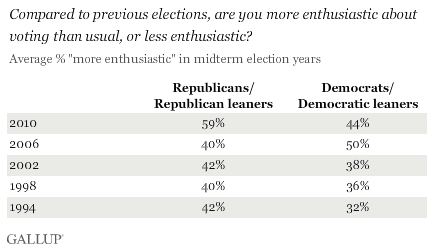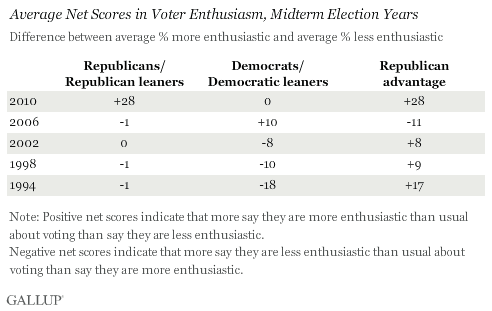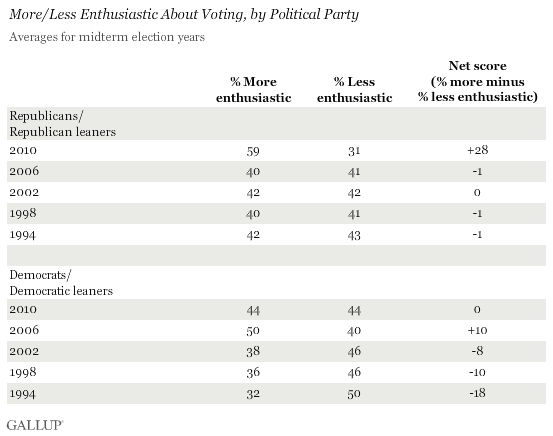PRINCETON, NJ -- An average of 59% of Republicans and Republican-leaning independents have said they are more enthusiastic than usual about voting this year compared with past elections, the highest average Gallup has found in a midterm election year for either party since the question was first asked in 1994.

The prior high for a party group was 50% more enthusiastic for Democrats in 2006, which is the only one of the last five midterm election years in which Democrats have had an enthusiasm advantage. In that election, Democrats won back control of the U.S. House of Representatives for the first time since 1994.
The current average is based on four measures of this enthusiasm question since February, including the recent June 11-13 USA Today/Gallup poll. In that poll, 53% of Republicans said they were more enthusiastic than usual about voting and 39% were less enthusiastic, while 35% of Democrats said they were more enthusiastic about voting and 56% were less enthusiastic.
Republicans' net score of +14 more enthusiastic in the latest poll compared with the Democrats' net score of -21 represents the largest relative party advantage Gallup has measured in a single midterm election-year poll. More generally, Republicans have shown a decided relative advantage in enthusiasm throughout 2010, averaging a net score of +28, compared with Democrats' net score of 0.
(Gallup instituted a separate enthusiasm question in March on its Daily tracking survey, which asks voters to say how enthusiastic they are about voting this year as opposed to comparing their current enthusiasm to their enthusiasm in prior elections. This new enthusiasm question lacks a historical trend but has also shown a consistent Republican advantage throughout the year.)
The 28 percentage-point party difference in net scores on the "more enthusiastic than usual" question in 2010 is the highest Gallup has measured in a midterm election year, with 1994's 17-point Republican advantage the only other midterm election-year gap coming close. (See the table at the end of the article for full data by party.)

The enthusiasm question has generally provided an accurate indication of which party will fare better in the midterm elections. Since 1994, the party that has had a relative advantage on the enthusiasm measure has gained congressional seats in that midterm election year. Specifically, Republicans gained seats in 1994 and 2002, while Democrats gained in 2006. In 1998, Democrats gained seats even though Republicans had an advantage on enthusiasm for most of the year. In the final poll before the 1998 midterm elections, Democrats held a slight two-point advantage in net enthusiasm.
Aside from 1998, party advantages in enthusiasm have been established early in a midterm election year and have persisted throughout the year. Thus, it would be unlikely, though not unprecedented, for political conditions to change enough between now and Election Day to wipe out the Republican advantage in enthusiasm. And if that advantage persists, the Republican Party will likely be celebrating gains in congressional seats after Election Day.
Survey Methods
Results for this USA Today/Gallup poll are based on telephone interviews conducted June 11-13, 2010, with a random sample of 1,014 adults, aged 18 and older, living in the continental U.S., selected using random-digit-dial sampling.
For results based on the total sample of national adults, one can say with 95% confidence that the maximum margin of sampling error is ±4 percentage points.
For results based on the total sample of 458 Republicans and Republican-leaning independents, one can say with 95% confidence that the maximum margin of sampling error is ±5 percentage points.
For results based on the total sample of 466 Democrats and Democratic-leaning independents, one can say with 95% confidence that the maximum margin of sampling error is ±5 percentage points.
Interviews are conducted with respondents on landline telephones (for respondents with a landline telephone) and cellular phones (for respondents who are cell phone-only). Each sample includes a minimum quota of 150 cell phone-only respondents and 850 landline respondents, with additional minimum quotas among landline respondents for gender within region. Landline respondents are chosen at random within each household on the basis of which member had the most recent birthday.
Samples are weighted by gender, age, race, education, region, and phone lines. Demographic weighting targets are based on the March 2009 Current Population Survey figures for the aged 18 and older non-institutionalized population living in continental U.S. telephone households. All reported margins of sampling error include the computed design effects for weighting and sample design.
In addition to sampling error, question wording and practical difficulties in conducting surveys can introduce error or bias into the findings of public opinion polls.
View methodology, full question results, and trend data.
For more details on Gallup's polling methodology, visit https://www.gallup.com/.

